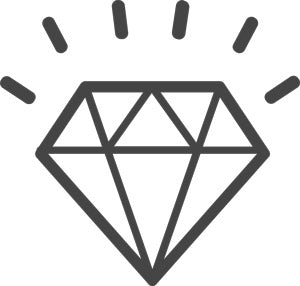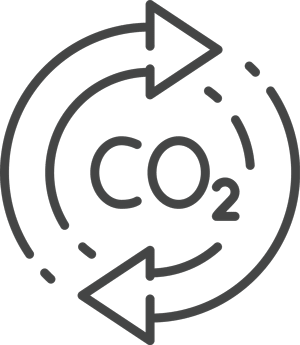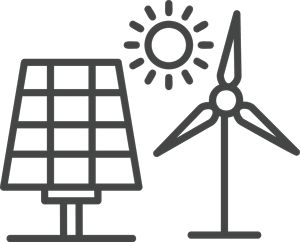We are unwavering in our commitment to helping reduce our reliance on fossil fuels and power a brighter tomorrow.
What is a sustainable diamond?
At Ethica, we only use lab grown diamonds bypassing the whole Conflict Free conversation entirely.
We built our company based on core values of integrity, innovation and transparency and we are uncompromising about delivering the highest quality diamonds. Every diamond set in our Ethica jewellery is hand picked from the highest type 11A standards, for our customers.
However, what they do not bypass by default is the sustainability conversation. It is not a given that lab grown diamonds are sustainable simply because they are grown in a lab and not mined.
One of the major challenges the traditional diamond mining industry faces is its reliance on fossil fuels and the energy required to grow a diamond in a lab is still significant, with carbon emissions recorded at being around 1 ton carbon for every 3 diamonds produced at 1 carat each. The way to ensure lab diamonds are sustainable is to record the energy used to grow them, and offset this carbon, or ensure the energy used to grow the diamond is from renewable sources.
Lab Grown Diamond FAQ's
Why are some lab diamonds cheaper than others?
Some growers may have more efficient machinery, others may differ in the country or origin (lab diamonds from India will be cheaper than those grown in the USA, for example), and others might have more expensive post growth treatment processes.
The biggest factor for the difference in price, though, is the quality of the diamond, as well as the cutting process afterwards.
Why are lab diamonds more sustainable?
Lab-grown diamonds are not harvested from mines, so the ethical and environmental impact of lab-grown diamonds cannot be compared to that of mined diamonds. Whilst the Kimberley Process (KP) has reduced the flow of mined conflict diamonds, opting for a lab-grown diamond eliminates the risk of purchasing a stone of questionable origin altogether.
Lab-grown diamonds have a smaller environmental footprint than mined diamonds and are 100% conflict-free. According to Frost & Sullivan, "growing diamonds cause[s] significantly less environmental impact as compared to mining diamonds. There are several aspects of environmental impact such as air pollution, water usage, energy usage, etc."
Our mission for 12 years has been to help the world transition to more sustainable gemstones – and we hope you will join us on this journey by choosing lab-grown diamonds and gemstones, a vote for a more sustainable future.
Can a lab diamond test as moissanite?
A diamond may be mistakenly identified as a moissanite when using some diamond testers due to their similarity in thermal conductivity. Professionals can easily distinguish between the two gems due to their differing refractive properties, with moissanites being double refractive and diamonds being single refractive.
Are lab grown diamonds flawless?
Like natural diamonds, lab created diamonds will vary in colour, clarity, and cut. Each one is unique. Lab created diamonds may contain minor internal or surface inclusions, comparable to high quality natural diamonds. Lab diamonds are evaluated and graded by independent gemological labs that certify natural diamonds, using the same strict standards.
Can you tell the difference between a natural diamond and a lab diamond?
Lab created diamonds display the same physical, chemical, and optical characteristics as natural diamonds, along with the same fire, scintillation, and sparkle. They are real diamonds. Lab created diamonds are nearly impossible to differentiate from natural diamonds with the naked eye. laboratory-made diamonds are indistinguishable from Earth-mined diamonds, even under a microscope, according to the Gemological Institute of America.
Will a lab grown diamond test positive for diamond?
Yes, these are real diamonds, which are pure crystallised carbon. Lab created diamonds will pass all tests used to confirm a pure carbon diamond.
What are the humanitarian benefits of lab diamonds?
We cannot speak to other companies’ lab created diamonds. However, our lab diamonds are created in highly controlled and technologically advanced environments, where worker safety and welfare is a priority, by employees being paid a fair and competitive wage.
Does a lab grown diamond have a resale value?
Buying an engagement ring or diamond, regardless of origin, with the intent to sell it in the future, is not a good investment. Many traditional jewellers tell consumers that lab created diamonds have little to no resale value, but this could not be further from the truth.
Most Earth-mined diamonds have resale value, and most lab created diamonds will have a similar resale value as well. Regardless of origin, either grown or mined, all diamonds are priced using an internationally accepted pricing system. This system is known as the Rapaport Price List. Resale values are based on a percentage of the Rapaport Price List.Place block content here
What does Type 11A mean?
Most people only think of just the 4’cs when judging the beauty of a diamond. However, there are also Types of diamonds. Type lA, llB and Type IIA, llB. In the past, we haven’t talked too much about the different types of diamonds because the superior Type ll has been unattainable to the majority of the population.
Type IA
98% of diamonds mined from the earth will be a Type lA diamond. These are very common diamonds that you will find at your local jewellers or online retailers.
Type IIA
Only 2% of diamonds mined will be a Type IIA diamond, making them very rare. They are special because they contain the purest form of carbon, with either very little or no nitrogen atoms in the crystal structure. This makes Type IIA diamonds harder and brighter than common Type lA diamonds. White diamonds are exceptionally colourless and coloured diamonds are often found with a brown, purple, blue, or pink tone.
Previously, Type IIA diamonds were only owned by royalty and the super-wealthy due to their incredible beauty and high calibre. For example, The Elizabeth Taylor Diamond and The Hope Diamond are both Type IIA Diamonds.
Ethica Diamonds only work with suppliers who grow superior Type 11A diamonds.
Type IIB
Type IIB diamonds, those defined as having trace amounts of substitutional boron, are prized for their blue colours. The famous Hope diamond is a perfect example. Besides their boron content, these rare diamonds are also characterised by their general lack of nitrogen. Little is known about how type IIB diamonds form, but they are especially intriguing because boron is often regarded as a crustal element whose presence in mantle-derived diamonds is unexpected.
Summary
- Type I diamonds are the most common. They represent 98% of all natural diamonds and have detectable traces of Nitrogen.
- Type IA diamonds contain clusters of Nitrogen atoms throughout the crystal structure of the stone. They tend to emit a yellowish tone.
- Type IB diamonds contain Nitrogen atoms as well. These atoms are all singular as opposed to clustered groups. These stones are 0.1% of all diamonds and emit a strong yellow, orange, brown and even green colour tone.
- Type IIA diamonds are the most valuable and consequently are very collectable items. They contain either very little or no Nitrogen atoms in the crystal structure of the stones. White stones are exceptionally colourless and fancy coloured diamonds are often found with a brown, purple, or pink tone. They represent only 1% – 2% of all diamonds.
- Type IIB diamonds contain elements of Boron within the structure. As a result, they often emit a blue or grey tone. They represent only 0.1% of diamonds. And consequently they are also very valuable.
How can I tell if a lab grown diamond is sustainable?
Ensuring that the lab diamond you choose comes from a sustainable diamond grower is important if you are looking for a genuinely ethical product. At Ethica, we work with carefully selected diamond growers who use renewable energy, offset carbon in some way, and adhere to the highest ethical working conditions,making them more sustainable than most other lab diamonds on the market. We are always looking for the latest innovations within the lab grown diamond and gemstone industry which match our company ethos and we’re proud to offer the most ethical options available.
When you buy a diamond through us, you can choose which supplier you’d like your lab diamond to be sourced from, as this will influence the price. We can provide details of each supplier and their sustainability efforts, meaning you can make an informed decision which suits your wishes and budget
What is an ethical diamond?
The true cost of creating a diamond falls under several headings, environmental, human and ethical.
Environment
Where natural diamonds are mined, a huge hole is created in the Earth, and a small city is created on the surface to process the diamonds from the rock retrieved, and accommodate the workers. This damages that piece of the Earth’s surface, probably forever. The waste, the spoil, is stacked up somewhere and left to scar the area. The water courses locally are re-shaped, often poisoned from the runoff. The trees and plants in the area are stripped away, and even if they’re replaced, the eco-systems will never be quite the same as the constitution of the soil will have changed. The animals that lived there will have moved, or died. The animals that used to migrate through the area will have been forced to use different routes to reach their destinations, putting extra strain on their bodies, causing weakness and ill health.
Human
In first-world countries, mine workers are often highly skilled workers, well paid and well looked-after. In poorer nations, where the industry is not so well regulated, diamond miners often work in treacherous conditions, where there is little concern for safety, and the pay is low. In some cases, there is no pay, and women and children are also effectively enslaved by the mine owners, or where the diamonds are sold to fund conflict and rebellion. The international diamond trade has tried to prevent these so-called ‘conflict diamonds’ from entering the market, by introducing the Kimberley Process, to verify diamonds’ ethical origins, but there are flaws and loopholes in this process, so you can never entirely guarantee that a mined diamond is free from human rights abuses.
What is Ethical?
At the very least, this means that the products we buy shouldn’t have a negative impact on the environment, animals or people who are linked to the creation of the product. But better still, looking for products and companies who go one step further by having a positive impact and supporting positive changes is when it actually feels good to spend your money. After all, if you are going to spend money, you may as well choose companies who make you feel good about doing so and ensure your money is being used to support something good.
For a truly ethical purchase, you should choose a man made diamond, not a naturally mined diamond and ensure that the lab diamond you choose comes from a sustainable diamond grower.
Isn't a natural diamond more authentic and meaningful?
In an ideal world, anything that is natural feels better than something that is forced or manufactured artificially. But we don’t live in an ideal world and we need to balance the pros and cons. Natural doesn’t always mean better.
If we take a look at flower growing as an example. Flowers that grow naturally almost certainly will be damaged at some point by rain, wind and pests. Whereas flowers that are grown in polytunnels are protected from these harsh conditions. Both flowers are beautiful, but the protected ones will almost indefinitely be more consistent.
Similarly, stones that are formed in natural Earth conditions are also exposed to harsh conditions that result in a large percentage of wasted stones that are unsuitable for jewellery due to poor quality.
To produce one carat of diamonds, miners sift through about 250 tons of rock and sediment with the average diamond coming out of a mine is just one tenth of a carat, which is very small. About 80% of approximately 142 million carats annually are used in industry for tools and cutting equipment etc. Only 20% are suitable for gems and of those, around just 2% are cut to the best standard.
Most of us would agree that all of this damage to our Earth is neither authentic or meaningful and if there is a kinder way, then it has to be better.
How do I know which lab diamond to choose?
To ensure the diamond is truly beautiful, it is important that the diamond you choose is Type 11A. These diamonds are icy-white and sparkle better than 98% of all natural diamonds; they are the rarest diamond types with a perfect carbon structure and present no milkiness or fluorescence, and appear brighter even to the naked eye.
However, there is more to consider than simply which type it is and, without the guidance of an expert, you cannot be sure the lab diamond you are buying online is as beautiful as you would want it to be.
The only thing you should need to concern yourself with when choosing a lab diamond is the shape and which of the 4 C's to priortise for your budget - you should leave the rest to an expert who can assess the factors which determine a diamond’s beauty that go beyond the 4Cs on a certificate. When it comes to the 4C’s, we would recommend staying above a G colour and nothing less than VS clarity. The cut should be excellent on the certificate, since the cut influences the sparkle the most, and should be approved by an expert, because what is written on paper and what is presented in person can be two different things. For example, fancy shapes do not have cut grades per se - they require a specialist to pass or fail the stone as truly beautiful, or not. An “excellent cut” on the certificate does not mean a pear diamond will not have a huge bow-tie, (not considered desirable) for example - details like this require expertise to determine, not solely a certificate.
Can I trust videos or photos of lab diamonds online?
Unfortunately, not always. Firstly, photos and videos alone are not enough to determine a good lab diamond from a bad one. Such assessments can only be done by physically looking at the diamond in person, and by someone with appropriate expertise. Secondly, we have seen instances of duplicate certificates, videos and images being used for different diamonds online, so you cannot always rely on the media provided by online retailers.
If you are buying the diamond online, make sure the retailer only stocks their diamonds from suppliers they have carefully selected for their quality production, and that the diamond is looked over by an expert. When you have these assurances, you are safe to proceed selecting a lab diamond from their inventory and you can focus on the 4C’s that are important to you, without stressing about anything else.
The lab diamonds we sell at Ethica Diamonds are all approved to be the very best quality. We use experts who can confidently identify colour defects, crystal material, undesirable inclusion types, poor growth process, and other characteristics that are outside of the 4C’s which deem a diamond worthy for our customers.
Do Ethica Diamonds sell natural diamonds too?
At Ethica, we specialise in lab grown diamonds and gemstones in our fine jewellery. We do this because we believe that lab grown diamonds and man made gemstones are the modern choice for expressions of love; expressions that do not harm our planet through mining, as well as requiring less energy to mine them. These benefits do not come as a cost to the quality either, in fact, quite the opposite. The lab diamonds that most people can afford are infinitely more beautiful and showstopping than the comparable mined diamond for the same budget. With lab grown, you can choose a Type 11A, D-E colour, VVS diamond for a reasonable cost, whereas if it were mined, it would cost tens of thousands of pounds.
What does it mean if my lab diamond is post growth treated?
This is a standard part of the growing process. Some lab grown diamonds receive an extra dose of high temperature and high pressure after growing, just as naturally growing diamonds would be under extreme heat and pressure in the earth as it grows. Please note, only a selection of our diamonds include treatment on the certificate. Some diamonds may be treated but this will not be declared on the certificate.













